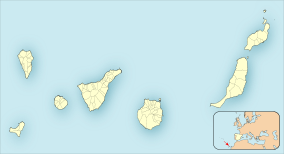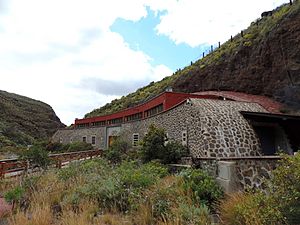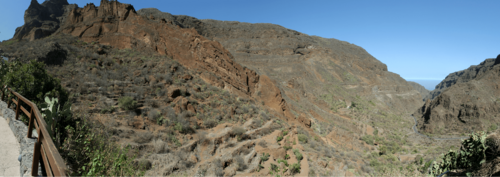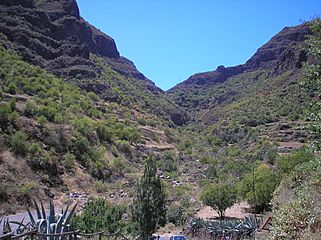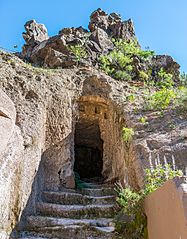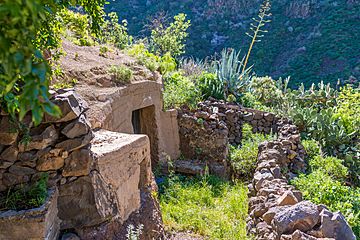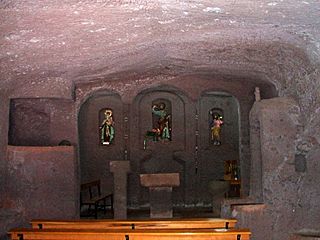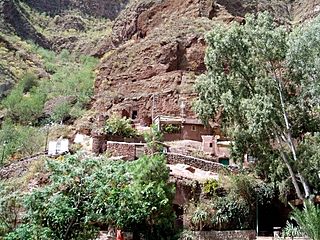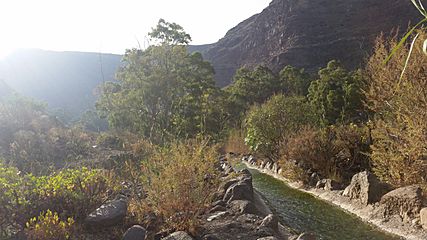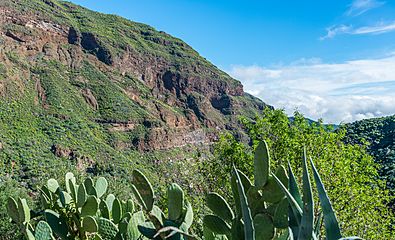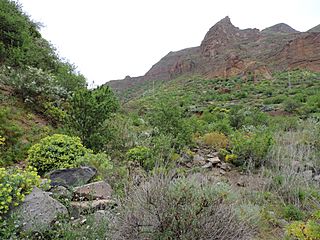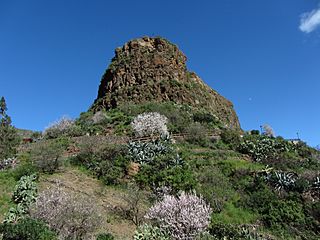Guayadeque ravine facts for kids
Quick facts for kids Guayadeque ravine |
|
|---|---|
|
IUCN Category III (Natural Monument)
|
|
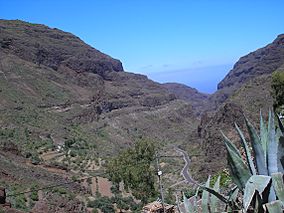
The valley, view towards the S-E and the sea
|
|
| Location | Ingenio and Agüimes, Las Palmas, Grand Canary island, Canary Islands, Spain |
| Length | 11 km (6.8 mi) |
| Area | 7.255 km2 (2.801 sq mi) |
The Guayadeque ravine, known in Spanish as Barranco de Guayadeque, is a special valley found on Grand Canary island. This island is part of the Canary Islands, located off the coast of Morocco. The ravine stretches across two towns: Ingenio and Agüimes.
This valley is one of the biggest ravines in the Canary Islands. It's famous for its amazing old ruins and for the unique plants and animals that live there. You can even find one of the largest lizard species here! The ravine is also well-known for its many cave houses. Some of these caves are even a church and restaurants, all dug right into the rock!
Contents
Exploring Guayadeque Valley
This beautiful valley is located in the southeastern part of Gran Canaria island. It begins at a place called Las Marteles crater, which is about 1,500 meters (4,921 feet) high. The valley then stretches from northwest to southeast. It forms a natural border between the towns of Ingenio and Agüimes, with Agüimes on the south side.
A road called GC-103 runs along the bottom of the valley, following the path of the Guayadeque stream. This road leads to Montaña de las Tierras, where you can find more cave-restaurants and cave-homes. On the way, the road passes through Bermeja cave, a small village about 4 kilometers (2.5 miles) from the visitors' center. Beyond Montaña de las Tierras, a walking path goes up to the Las Marteles crater.
The sides of the valley are very steep, rising over 300 meters (984 feet) and sometimes even 400 meters (1,312 feet) high. You'll see many terraced areas built into the slopes for farming. Fig trees and almond trees are very common here. The valley's landscape was shaped by ancient volcanoes and by the slow process of erosion. The ground is mostly made of basalt rocks, which come from cooled lava.
What Does Guayadeque Mean?
The name Guayadeque comes from the old language spoken by the people who lived here long ago. According to Ignacio Reyes, a language expert, it means "tranquil spirit" or "reserve of tranquillity." This name perfectly describes the peaceful feeling you get in the valley.
Ancient History and Cave Dwellings
Long ago, Guayadeque was the most populated valley on the island. It has hundreds of caves! The people who lived here left behind many mummies and other burial items in some of these caves. These special burial caves were often hard to reach, which helped keep them safe. Some of these caves include Labour cave, Numerous caves, Canary Cliff, Vincent Cliff, and Black Cliff. Because of this, the ravine is one of the most important ancient burial sites on the island.
Later, these caves were used for different purposes. People lived in them, stored food, and even held special ceremonies. Sometimes, burial caves were reused, but people were careful to protect the skulls with stones. In Guayadeque, they even covered them with animal skins or woven reed mats.
In the 1800s, many valuable items were taken from these ancient burial sites. Many of these items ended up in the Canarian museum in Las Palmas, which bought them to protect them. To stop further damage, the site was later made a nature reserve. The valley also has many remains of old water mills, showing how important water was to the people who lived here.
You can learn more about the valley's human history at the Guayadeque museum. It's called the Centre of Archaeological Interpretation in Spanish (Museo de Guayadeque – Centro de Interpretación Arqueológica). This museum is located at the start of the GC-103 road and shows how people lived in the valley, going all the way back to ancient times.
Amazing Plants and Animals
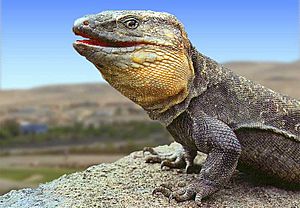
The Guayadeque ravine is home to over 80 species of plants and animals that are found nowhere else in the world! One of the most famous is the Gallotia stehlini, also known as the Canarian Giant Lizard (Lagarto Canarión). This is the largest lizard species in Europe and Africa, and it can grow up to 80 centimeters (31 inches) long!
The valley's plant life is also very special. You can find plants that like warm weather and other rare species growing on the steep slopes. Some examples include Kunkeliella canariensis, which is a plant from the sandalwood family, Helianthemum tholiforme, and Polycarpaea filifolia. Many other plants found here are unique to Gran Canaria island.
Life in the Caves Today
Today, not many people live in the Guayadeque valley, but there are still a few small communities. One of these is Cueva Bermeja, which means "Red Cave." This small village gets its name from the color of the rock. Another community is in "Las Tierras Mountains," where you'll find the Saint John-the-Baptist hermitage (a small church).
In both these areas, you can find services, restaurants, and souvenir shops. It's a great place to try local wine and delicious traditional foods like fried pork and Canarian wrinkly potatoes.
Protecting Guayadeque
The Guayadeque valley is a very important place, so it has special protection. On June 21, 1991, it was officially listed as a Spanish Heritage site. This means it's recognized as an "Archaeological site" and is protected by the law of Historical Heritage of the Canaries.
It has also been named a Natural Monument by the Law on Natural Areas of the Canaries. Plus, it's part of the European Heritage network of natural landscapes, specifically recognized as a "troglodyte zone" because of its many caves.
How to Visit
You can reach the Guayadeque valley by taking the GC-103 road. This road starts in Agüimes from the GC-100 road. The GC-100 road goes south to Arinaga and north through Ingenio, Cuatro Puertas, and Telde.
There's a visitors' center located inside a cave at the entrance of the valley. It's open from Tuesday to Sunday all year round, ready to welcome you and help you learn more about this amazing place!
Gallery
See also
 In Spanish: Barranco de Guayadeque para niños
In Spanish: Barranco de Guayadeque para niños


